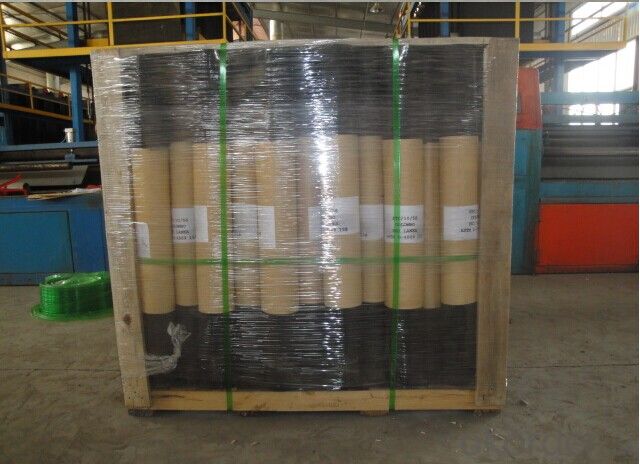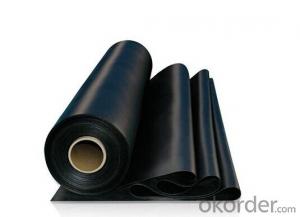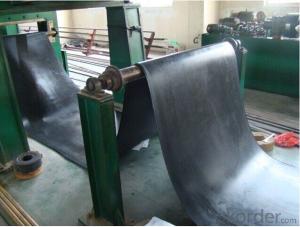EPDM Rubber Waterproof Membrane Pond Liner Use
- Loading Port:
- Qingdao
- Payment Terms:
- TT OR LC
- Min Order Qty:
- 2000 m²
- Supply Capability:
- 300000 m²/month
OKorder Service Pledge
OKorder Financial Service
You Might Also Like
EPDM Waterproof Membrane
Product characteristics for EPDM Waterproof Membrane
1>Excellent anti-aging performance, service life up to 50 years
2>Working well with in -40°C to 100°C,it can be constructed with a single layer in ambient temperature.
3>Waterproofing on various kinds of underground project,industrial of civil buildings and structures. 4>high extension rate, high tensile strength, small size changes at heat treatment
5>Good plant roots penetrability resistance and can be made waterproofing layer of planting roof
6>Special modified molecular structure ,effectively resolving the current domestic and foreign glue joint problem .
7>Good low temperature flexibility, and good performance of adapting to ambient temperature changes. 8>Convenient application ,solid joint, no environment pollution
9>chemical corrosion Resistance, can be used for special occasions
Uses for EPDM Waterproof Membrane
Widely used in roofs, basement, toilet ,swimming pool, and all kinds of industry and civil building waterproofing, reservoir, vivicism, bridge, underground, tunnel and dam waterproofing ,especially to the keystone waterproofing projects which is durability, high corrosion resistance and easy deformation
Specification for EPDM Waterproof Membrane
Item | Thick(mm) | Width | Length(m) | Color |
Spe | 1.0—2.0 | 1.2m/2m/3m/4m | 20 | Black |
Deviation | -1 +15 | --1 | Multicolor |
Technical Data for EPDM Waterproof Membrane
Item | value | ||
JL1 | JF1 | ||
Tensile Strength (Mpa) | normal tamperature | 7.5 | 4.0 |
60°C ≥ | 2.3 | 0.8 | |
Elongation at break (%) | normal tamperature ≥ | 450 | 450 |
-20°C ≥ | 200 | 200 | |
Tear Resistance (N) | ≥ | 25 | 18 |
Water impermeability | 30mm | 0.3Mpa | 0.3Mpa |
Cold bending | (°C) ≤ | -40 | -30 |
Heating Shrinking rate | extand << span=""> | 2 | 2 |
shrink << span=""> | 4 | 4 | |

FAQ:
Can you produce 4m width?
Yes, no problem for us. We have four bases in China, largest one in this field.
How many quantity in one 20'' container for 1.2mm and 1.5mm?
480rolls, 11520m2 for 1.2mm and 400rolls, 9600m2 for 1.5mm
Can you provide free samples?
Yes, our samples are free, but express fees usually on buyer's account.
- Q:Are there any specific considerations for installing a waterproofing membrane on wood surfaces?
- Yes, there are several specific considerations when installing a waterproofing membrane on wood surfaces. First and foremost, it is important to ensure that the wood surface is clean, dry, and free from any dirt, dust, or debris. This will help to create a proper bond between the wood and the waterproofing membrane. Additionally, it is crucial to choose a waterproofing membrane that is specifically designed for wood surfaces. There are different types of membranes available, such as liquid-applied membranes or sheet membranes, so selecting the right one is essential. Before applying the membrane, it is advisable to prime the wood surface with a suitable primer. This will help to enhance the adhesion of the membrane and provide a more durable and long-lasting waterproofing solution. It is also important to consider the climate and weather conditions in the area where the wood surface is located. If the area is prone to extreme temperatures or heavy rainfall, it is recommended to choose a waterproofing membrane that can withstand these conditions and provide adequate protection. Furthermore, proper installation techniques should be followed to ensure the membrane is applied correctly. This may involve rolling or brushing the membrane onto the wood surface, as per the manufacturer's instructions. It is crucial to pay attention to details such as seams, corners, and edges to ensure a watertight seal. Regular maintenance and inspection are essential for the longevity of the waterproofing membrane on wood surfaces. It is important to check for any signs of damage, such as cracks or peeling, and address them promptly to prevent water infiltration and potential damage to the wood. In summary, when installing a waterproofing membrane on wood surfaces, it is crucial to prepare the surface properly, choose the right type of membrane, consider the climate and weather conditions, follow proper installation techniques, and perform regular maintenance and inspection. By doing so, you can effectively protect the wood surface from water damage and ensure its longevity.
- Q:Are waterproofing membranes resistant to water vapor transmission?
- Waterproofing membranes possess a resistance to the transmission of water vapor. These membranes function to construct a barrier, effectively hindering water penetration. Typically composed of impermeable materials like rubber, plastic, or bitumen, they effectively obstruct the flow of liquid water, preventing its infiltration into the underlying structure. Nevertheless, it is worth noting that although waterproofing membranes can effectively resist the transmission of water vapor, it may not entirely eradicate it. A certain degree of water vapor may still manage to permeate the membrane, albeit significantly reduced in comparison to materials not specifically intended for waterproofing.
- Q:Can a waterproofing membrane be used on elevator shafts?
- Elevator shafts, when faced with water infiltration, particularly in areas with high water tables or during heavy rainfall, can benefit from the use of a waterproofing membrane. By applying a waterproofing membrane to the walls and floor of the elevator shaft, a reliable shield against water penetration can be established. This membrane, typically composed of sturdy materials like bitumen or rubberized asphalt, is applied in multiple layers to guarantee optimal protection. Serving as a waterproof barrier, it effectively halts water from seeping into the shaft and causing harm to the elevator equipment or building structure. Moreover, the waterproofing membrane aids in moisture and condensation control, averting issues such as mold growth. Proper installation and maintenance of the membrane are vital to ensure its continued effectiveness in preserving the dryness and safeguarding of the elevator shaft.
- Q:Can a waterproofing membrane be used on precast cement board surfaces?
- Precast cement board surfaces, commonly utilized in construction, particularly for exterior applications, can benefit from the application of a waterproofing membrane. These surfaces are not inherently waterproof, making it necessary to add an extra layer of protection against water infiltration. The waterproofing membrane, a thin material layer, serves as a barrier on the cement board surface. Its primary function is to prevent water from penetrating the board and reaching the underlying structure. This becomes particularly crucial in areas exposed to moisture, such as bathrooms, kitchens, and outdoor installations. Various types of waterproofing membranes are available, including liquid-applied membranes and sheet membranes. Liquid-applied membranes can be rolled or sprayed onto the surface, while sheet membranes are applied similarly to stickers. Both options effectively waterproof precast cement board surfaces. When selecting a waterproofing membrane for precast cement board surfaces, it is vital to consider the specific requirements and conditions of the project. Factors such as water exposure level, climate, and intended use of the surface should be taken into account. Following the manufacturer's instructions for application is also crucial, as proper installation significantly impacts the membrane's effectiveness. To summarize, the utilization of a waterproofing membrane on precast cement board surfaces provides an additional safeguard against water infiltration. This wise choice is especially beneficial in moisture-prone areas, ultimately extending the lifespan of the cement board and preventing harm to the underlying structure.
- Q:Can a waterproofing membrane be used in high-rise buildings?
- Yes, a waterproofing membrane can be used in high-rise buildings. It is commonly utilized in high-rise buildings to prevent water infiltration and protect the structure from potential damages caused by moisture. The membrane is applied to various surfaces such as roofs, foundations, and walls to create a barrier against water penetration, ensuring the building remains dry and structurally sound.
- Q:What are the different types of waterproofing membranes?
- Construction and building projects commonly utilize various types of waterproofing membranes to prevent water penetration through walls, roofs, or other structures. These membranes can be applied to different surfaces. 1. Bituminous Membranes: Comprised of bitumen, polymers, and reinforcement materials like fiberglass or polyester, bituminous waterproofing membranes are frequently employed in roofing applications. They can be applied using hot or cold processes and offer outstanding waterproofing properties and durability. 2. PVC Membranes: Synthetic PVC membranes exhibit high resistance to water, chemicals, and UV radiation. They are often used in roofing applications, particularly for flat or low-slope roofs. PVC membranes are lightweight, flexible, and easy to install, boasting long-lasting waterproofing protection while being puncture and tear-resistant. 3. EPDM Membranes: Synthetic rubber EPDM membranes find common use in roofing applications. These membranes are highly durable, flexible, and resistant to UV radiation, ozone, and extreme temperatures. They can be installed as a single-ply membrane or in combination with other materials. 4. TPO Membranes: TPO membranes, a type of single-ply roofing membrane, are commonly employed in commercial and industrial settings. Composed of polymer blends and reinforcement materials, TPO membranes exhibit high resistance to water, chemicals, and UV radiation. They are lightweight, flexible, and easy to install. 5. Liquid Applied Membranes: Liquid applied membranes are an application type where the waterproofing system is initially liquid and cures to form a seamless and flexible membrane. These membranes can be made from various materials such as acrylic, polyurethane, or rubber-based compounds. They are often used for below-grade applications like basements or foundations, as well as roofs or other surfaces. To ensure effective and long-lasting waterproofing protection, it is crucial to consider the specific project requirements and consult with professionals to determine the most suitable type of waterproofing membrane.
- Q:Can a waterproofing membrane be applied to metal surfaces?
- Yes, a waterproofing membrane can be applied to metal surfaces. Waterproofing membranes are versatile and can be used on various materials, including metals. They are commonly used to protect metal surfaces from corrosion and water damage. The membrane acts as a barrier, preventing moisture from seeping into the metal and causing rust or other forms of deterioration. Additionally, waterproofing membranes can also provide additional insulation and improve the overall durability of the metal surface. It is important to choose a waterproofing membrane that is specifically designed for metal surfaces to ensure proper adhesion and long-lasting protection.
- Q:Can a waterproofing membrane be used for green roofs?
- Yes, a waterproofing membrane can be used for green roofs. In fact, it is a crucial component of the green roof system. A green roof consists of a layer of vegetation, growing medium, and a waterproofing membrane that prevents water from seeping into the building. The waterproofing membrane acts as a barrier to protect the structure underneath from water damage. It is designed to withstand the constant exposure to moisture and ensure that water does not penetrate through to the building. Additionally, the membrane helps to retain water within the green roof system, allowing for proper drainage and irrigation. Therefore, a high-quality waterproofing membrane is essential for the successful installation and functioning of a green roof.
- Q:Can a waterproofing membrane be used for tunnels and underground structures?
- Yes, a waterproofing membrane can be used for tunnels and underground structures. Waterproofing membranes are commonly used in construction to provide a barrier against water infiltration and protect structures from potential damage caused by water. In the case of tunnels and underground structures, where there is a higher risk of water ingress due to the surrounding soil and groundwater, waterproofing membranes are essential to ensure the integrity and longevity of the infrastructure. Waterproofing membranes for tunnels and underground structures are specifically designed to withstand the unique challenges posed by these environments. They are typically made of durable and flexible materials such as bitumen, PVC, or EPDM, which can effectively resist water pressure and provide long-lasting protection. Additionally, these membranes are often reinforced with various layers or fabrics to enhance their strength and resistance to puncture or tear. The application of waterproofing membranes in tunnels and underground structures involves a meticulous process. The surfaces that need to be waterproofed, such as the walls and floors, are thoroughly cleaned and prepared to ensure proper adhesion of the membrane. The membrane is then applied in multiple layers, ensuring complete coverage and a seamless seal. Special attention is given to critical areas such as joints, corners, and penetrations to prevent any potential weak points. By using a waterproofing membrane, tunnels and underground structures can be effectively protected from water intrusion, groundwater pressure, and potential damage caused by moisture. This helps to maintain the structural integrity of the infrastructure, prevent water-related problems such as leaks, corrosion, or deterioration, and ensure the safety and functionality of the tunnel or underground facility.
- Q:Can a waterproofing membrane be used on precast brick block surfaces?
- Precast brick block surfaces can indeed benefit from the application of a waterproofing membrane. Such a membrane serves as a protective shield, safeguarding the bricks against water infiltration, which could otherwise lead to undesirable consequences like cracks, efflorescence, or the growth of mold. It is crucial to select a waterproofing membrane explicitly designed for masonry surfaces, as these membranes are specially formulated to adhere perfectly to the distinct properties of brick and block materials. Moreover, to guarantee the membrane's effectiveness, it is essential to adhere to proper surface preparation and application techniques.
1. Manufacturer Overview |
|
|---|---|
| Location | |
| Year Established | |
| Annual Output Value | |
| Main Markets | |
| Company Certifications | |
2. Manufacturer Certificates |
|
|---|---|
| a) Certification Name | |
| Range | |
| Reference | |
| Validity Period | |
3. Manufacturer Capability |
|
|---|---|
| a)Trade Capacity | |
| Nearest Port | |
| Export Percentage | |
| No.of Employees in Trade Department | |
| Language Spoken: | |
| b)Factory Information | |
| Factory Size: | |
| No. of Production Lines | |
| Contract Manufacturing | |
| Product Price Range | |
Send your message to us
EPDM Rubber Waterproof Membrane Pond Liner Use
- Loading Port:
- Qingdao
- Payment Terms:
- TT OR LC
- Min Order Qty:
- 2000 m²
- Supply Capability:
- 300000 m²/month
OKorder Service Pledge
OKorder Financial Service
Similar products
New products
Hot products
Hot Searches
Related keywords




























